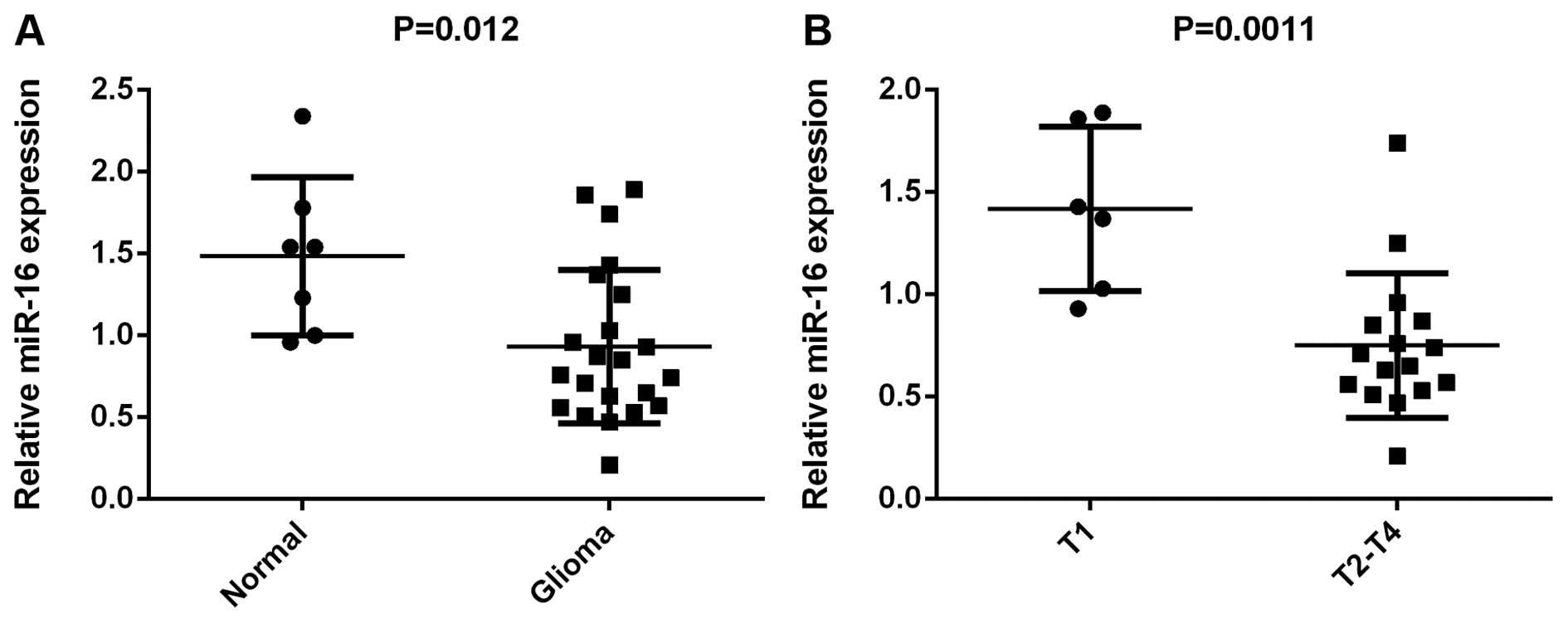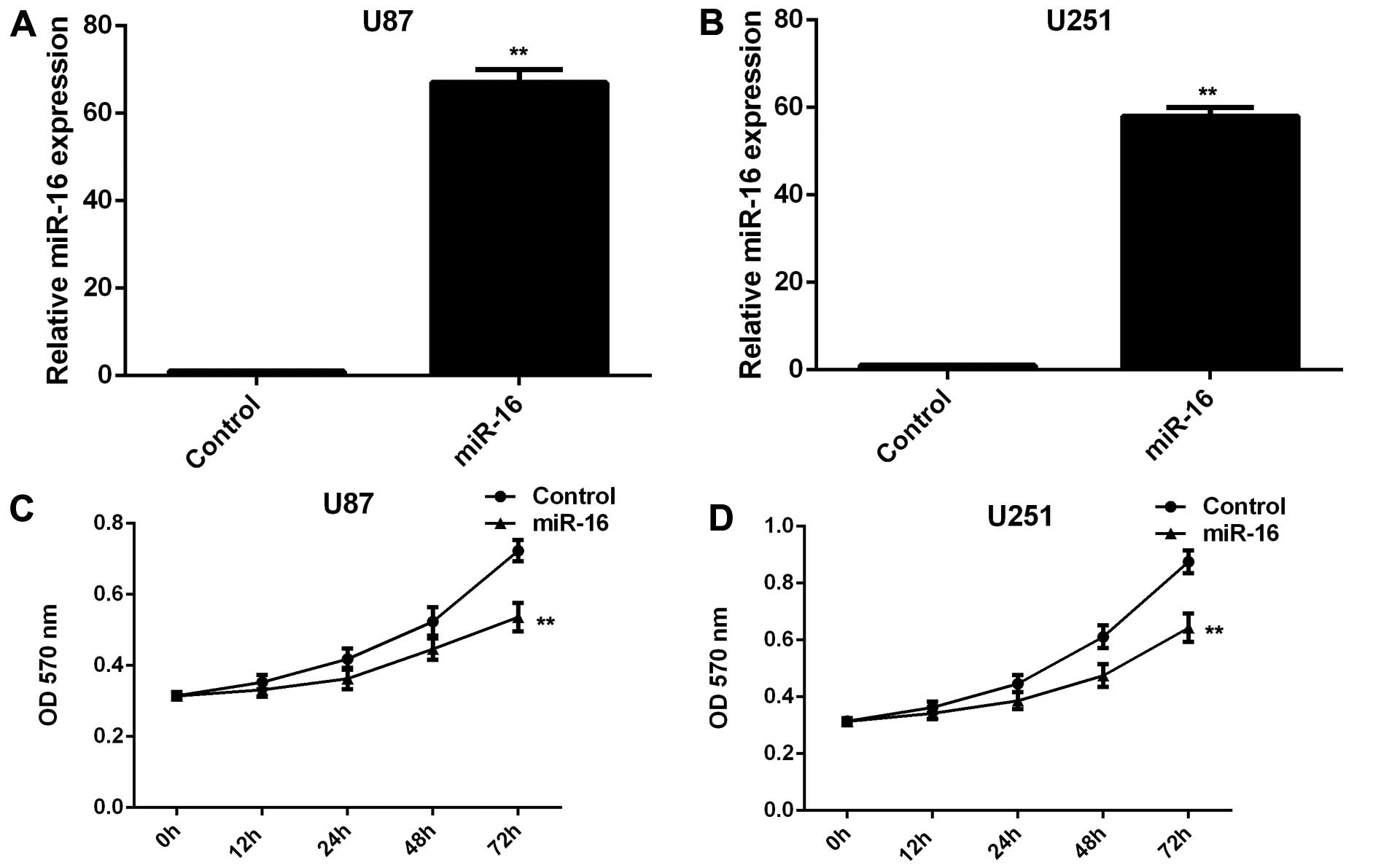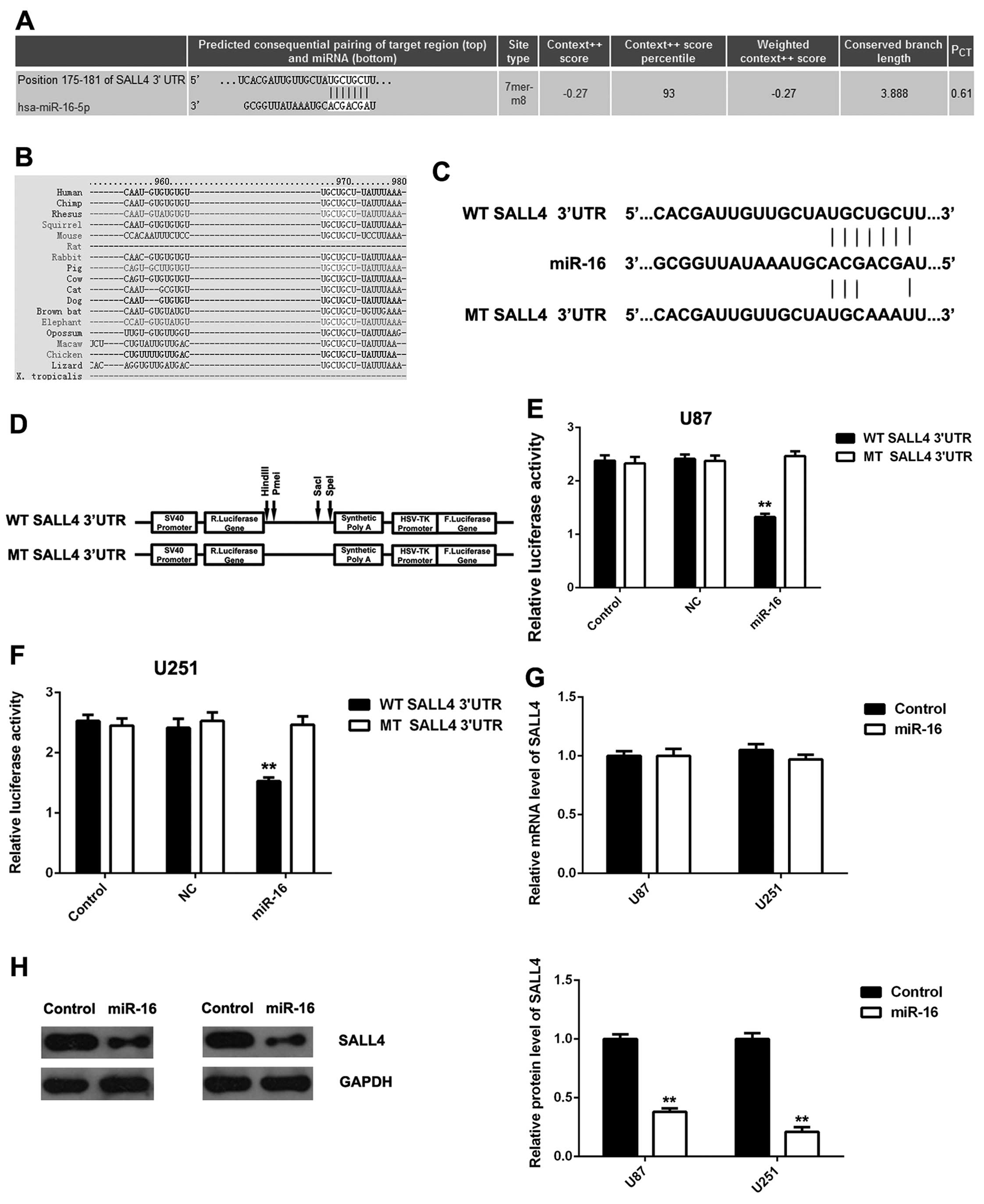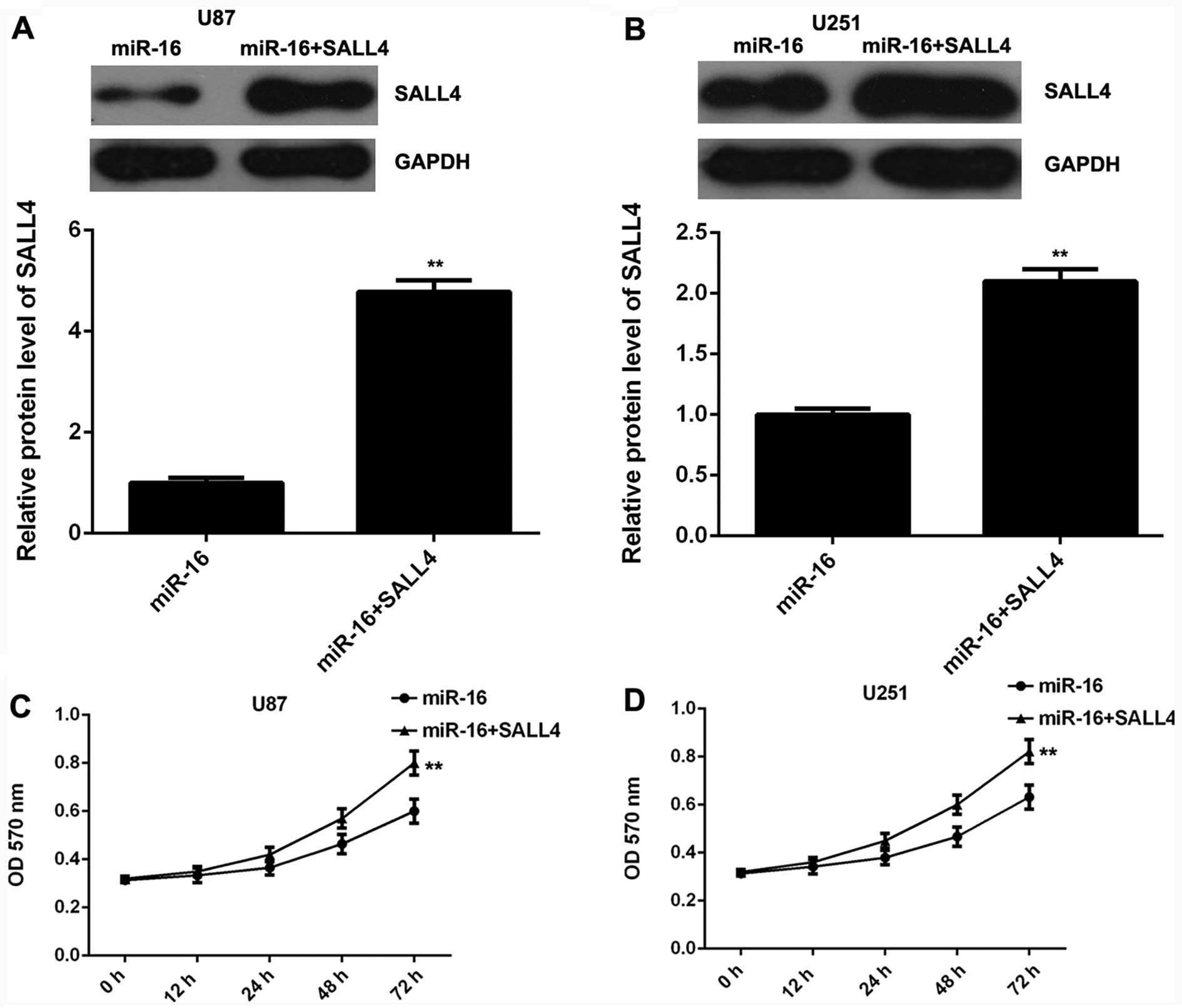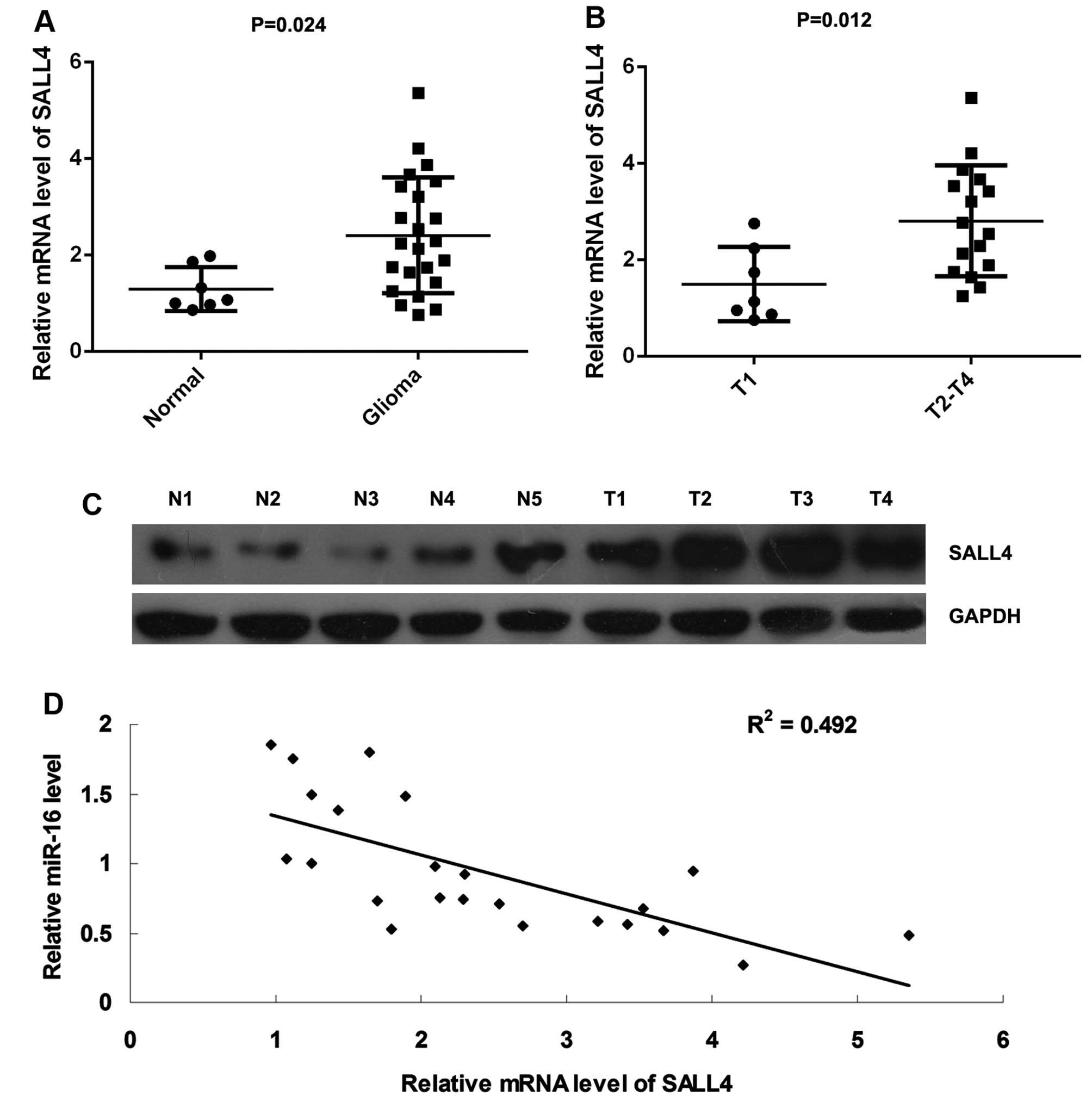MicroRNA-16 inhibits the proliferation, migration and invasion of glioma cells by targeting Sal-like protein 4
- Authors:
- Published online on: October 17, 2016 https://doi.org/10.3892/ijmm.2016.2775
- Pages: 1768-1776
Abstract
Instruction
Glioma is the most common malignant tumor of the brain, and accounts for approximately 30% of central nervous system tumors and 80% of all malignant brain tumors (1). Despite the remarkable development of therapies for other types of cancer in recent decades, the prognosis of patients with advanced glioma remains poor, mainly due to its resistance to radiotherapy, chemotherapy and adjuvant therapies (2–5). The deregulation of oncogenes or tumor suppressors has been implicated in glioma (6). Therefore, the investigation of the roles of genetic and epigenetic factors may aid in the developmetn of novel diagnostic and therapeutic strategies for glioma (7).
MicroRNAs (miRNAs or miRs), a class of non-coding RNAs 18–25 nucleotides in length, which are able to suppress gene expression by targeting the complementary regions of mRNAs and inhibiting protein translation (8). By negatively mediating their target genes, miRNAs act as key regulators in a variety of physiological and pathological biological processes, including tumorigenesis (9,10). The deregulation of miRNAs has been observed in glioma, and is associated with tumor growth, metastasis and drug resistance (11,12). Therefore, the investigation of the regulatory mechanisms of miRNAs is important for the treatment of glioma.
Recently, miR-16 has been implicated in the development and progression of glioma (13). Malzkorn et al investigated the expression profiles of 157 miRNAs in 4 patients with primary WHO grade II gliomas that spontaneously progressed to WHO grade IV secondary glioblastomas, and found that miR-16 showed increased an expression upon progression, suggesting that its upregulation may play a role in the progression of glioma (14). On the contrary, however, the following studies identified miR-16 as a tumor suppressor in glioma, by demonstrating that miR-16 exerts inhibitory effects on growth, migration, invasion, epithelial-mesenchymal transition (EMT), and angiogenesis in glioma (13,15–17). Moreover, several targets of miR-16 have been identified in glioma, including Zyxin, Bcl-2, matrix metalloproteinase (MMP)9 and BMI1 proto-oncogene, polycomb ring finger Bmi-1 (13,15,17). As one miRNA has many targets (18), whether other targets are also involved in the miR-16-mediated inhibition of glioma remains unknown.
Sal-like protein 4 (SALL4) is a zinc finger transcription factor, and has been identified as a marker for stem cells, involved in the maintenance of self-renewal in embryonic stem cells (19). Moreover, SALL4 was recently identified as an important biomarker for several common human cancers (20,21). Zhang et al found that SALL4 was significantly upregulated in glioma, and a high level of SALL4 expression correlated with a poor outcome (22). A previous study demonstrated that the upregulation of SALL4, caused by the low expression of miR-107, inhibited cell apoptosis in glioma (23). Accordingly, SALL4 acts as an oncogene in glioma, and may become an important target for the treatment of glioma. However, evidence of the regulatory mechanisms of SALL4 expression in glioma is limited.
In the present study, we aimed to investigate the regulatory mechanisms of miR-16 in glioma growth and metastasis. We found that miR-16 was significantly downregulated in glioma tissues compared to normal brain tissues, and that the reduced miR-16 levels were associated with a greater malignancy of glioma. We further revealed that miR-16 inhibited cell proliferation, migration and invasion, and EMT in glioma, at least in part by directly targeting SALL4, which was markedly upregulated in glioma tissues and inversely correlated with the miR-16 levels.
Materials and methods
Ethics statement and clinical sample collection
This study was approved by the Ethics Committee of Central South University, Changsha, China. A total of 23 cases of glioma specimens and 7 cases of non-tumorous brain tissues were collected from the Second Xiangya Hospital of Central South University between January 2012 and March 2013. Non-tumorous brain tissues were collected by the partial resection of normal brain tissue in order to reduce increased intracranial pressure in the treatment of severe head injury. All tissue samples were immediately snap-frozen in liquid nitrogen and stored at −80°C until use.
Written informed consent was obtained from all patients involved in this study. All glioma patients included 14 males and 9 females who ranged in age from 35 to 71 years, with a mean age of 51.3 years. None of the patients had any radiotherapy or chemotherapy prior to surgical resection. The glioma specimens were classified according to the World Health Organization (WHO) criteria (24). Among these glioma samples, 5 cases were pilocytic astrocytomas (WHO I), 6 were diffuse astrocytomas (WHO II), 6 were anaplastic astrocytomas (WHO III), and 6 were glioblastomas (WHO IV).
Cell culture and transfection
The human glioma cell lines, U87 and U251, were obtained from the Chinese Academy of Sciences (Shanghai, China). The cells were cultured in Dulbecco's modified Eagle's medium (DMEM) supplemented with 10% fetal bovine serum (FBS) (both from Life Technologies, Carlsbad, CA, USA) at 37°C in a humidified incubator containing 5% CO2. Lipofectamine 2000 (Life Technologies) was used to perform transfection according to the manufacturer's instructions. Briefly, the U87 and U251 cells were cultured to 70% confluence, and resuspended in serum-free medium. Scramble miR (miR-NC), miR-16 mimic, miR-16 inhibitor (all from Genecopoeia, Rockville, MD, USA), the pc-DNA3.1-SALL4 plasmid (Amspring, Changsha, China), and Lipofectamine 2000 were diluted in OPTI-MEM (Life Technologies). The diluted Lipofectamine 2000 was added to the diluted miR or plasmid, and incubated for 20 min at room temperature, and then added to the cell suspension. Following incubation at 37°C, 5% CO2 for 6 h, the transfection mixture was replaced with DMEM with 10% FBS. The cells were then cultured for 48 h prior to being used in the following assays.
Reverse transcription-quantitative PCR (RT-qPCR)
Total RNA was extracted from the tissues and cells using TRIzol Reagent (Life Technologies) in accordance with the manufacturer' s instructions. RT-qPCR was used to examine the relative miR-16 expression using the mirVana™ qRT-PCR microRNA detection kit (Life Technologies) in accordance with the manufacturer' s instructions. U6 was used as an internal reference. The relative mRNA expression of SALL4 was detected by RT-qPCR using the standard SYBR-Green RT-PCR kit (Takara, Otsu, Japan) in accordance with the manufacturer's instructions. Glyceraldehyde 3-phosphate dehydrogenase (GAPDH) was used as an internal reference. For both miRNA and mRNA detection, the reaction conditions were 95°C for 3 min, followed by 40 cycles of 95°C for 15 sec and 60°C for 30 sec. The specific primers for miR-16 and U6 were purchased from Genecopoeia. The specific primers for SALL4 were as follows: forward, 5′-TAGCCCTGCGTA GCCAGTTA-3′ and reverse, 5′-TCATGCTTAGTCCACT GTCTGT-3′. The specific primers for GAPDH were as follows: forward, 5′-ACAACTTTGGTATCGTGGAAGG-3′ and reverse, 5′-GCCATCACGCCACAGTTTC-3′. The relative expression level was quantified using the 2−ΔΔCt method.
3-(4,5-Dimethylthiazol-2-yl)-2,5-diphenyltetrazolium bromide (MTT) assay
Cell proliferation was examined by MTT assay. The U87 and U251 cells (2×103) were seeded in a 96-well plate. Each well was supplemented with 100 µl of fresh serum-free medium with 0.5 g/l MTT. Following incubation at 37°C, 5% CO2 for 12, 24, 48 and 72 h, the medium containing MTT was removed, and 50 μl of DMSO were added to each well. Following incubation at 37°C, 5% CO2 for 10 min, the absorbance at 570 nm (A570) of each sample was measured using a plate reader (Tecan Infinite M200; Tecan, Männedorf, Switzerland).
Wound healing assay
Wound healing assay was used to examine the migratory capacity of the glioma cells. The U87 and U251 cells were cultured to full confluence. Wounds of approximately 1 mm in width were created using a plastic scriber. The cells were washed and then cultured in DMEM containing 10% FBS for 48 h. The cells were then observed and photographed under a microscope (BX53; Olympus, Tokyo, Japan).
Transwell assay
Cell invasion was examined using 24-well Transwell chambers with a layer of Matrigel (Chemicon, Temecula, CA, USA). For each group, 300 μl of cell suspension, each containing 5,000 cells, was added to the upper chamber. DMEM containing 10% FBS was added to the lower chamber. Following culture for 24 h, non-invading cells on the interior of the inserts were removed using a cotton-tipped swab. Invading cells on the lower surface of the inserts were stained with 0.1% gentian violet (Sigma, St. Louis, MO, USA), rinsed with water, and dried in air. The invading cells were observed under a microscope (BX53; Olympus). The cell number was counted.
Western blot analysis
The cells were lysed in protein lysis buffer (Xinyu Biotechnology, Shanghai, China). The protein concentration was determined using the BCA Protein assay kit (Pierce Chemical Co., Rockford, IL, USA). Protein was separated with 10% sodium dodecyl sulfate-polyacrylamide gel electrophoresis (SDS-PAGE), transferred onto a PVDF membrane (Life Technologies), and then blocked in 5% non-fat dried milk (Mengniu, Beijing, China) in TBST (Sigma) for 2 h. The PVDF membrane was then incubated with primary antibodies against SALL4 (rabbit polyclonal; ab29112) or GAPDH (rabbit polyclonal; ab9485) (Abcam, Cambridge, MA, USA) at 4°C overnight, and then washed with TBST 4 times. The PVDF membrane was incubated with mouse anti-rabbit secondary antibody (ab99702; Abcam) for 1 h at room temperature, and then washed with TBST 3 times. The immune complexes were then detected using the ECL western blotting kit (Pierce Chemical Co.) and X-film (Kodak, Tokyo, Japan). ImageJ software was used to analyze the relative protein expression, represented as the density ratio versus GAPDH.
Bioinformatics analysis
TargetScan Human 7.0 online software (www.targetscan.org) was used to predict the putative target of miR-16.
Dual luciferase reporter assay
The wild-type (WT) sequence of the 3′UTR of SALL4 was constructed by PCR and inserted into the pMiR-Report miRNA Expression Reporter vector (Thermo Fisher Scientific, Carlsbad, CA USA). The mutant type (MT) sequence of the 3′UTR of SALL4 was constructed using the Easy Mutagenesis System kit (Promega, Madison, WI, USA) in accordance with the manufacturer's instructions, and then inserted into the pMiR-Report miRNA Expression Reporter vector. The U87 and U251 cells were co-transfected with the WT SALL4-3′UTR plasmid (200 ng) or the MT SALL4-3′UTR plasmid (200 ng), and miR-NC (100 nM) or miR-16 mimic (100 nM), using Lipofectamine 2000. Following co-transfection for 48 h, the dual-luciferase reporter assay system (Promega) was used to determine the activities of Renilla luciferase and Firefly luciferase. The Renilla luciferase activity was normalized to the Firefly luciferase activity.
Statistical analysis
The data in this study are expressed as the means ± SD. Statistical analysis was performed using SPSS 17.0 (SPSS, Armonk, NY, USA). The differences between 2 groups were analyzed using the Student' t-test. The differences among more than 2 groups were analyzed using ANOVA. A value of P<0.05 was considered to indicate a statistically significant difference.
Results
miR-16 is downregulated in glioma
To reveal the role of miR-16 in glioma, RT-qPCR was used to determine its expression levels. The expression levels of miR-16 were markedly reduced in the glioma tissues compared to the normal brain tissues (Fig. 1). Moreover, its levels were markedly lower in the glioma tissues at stages T2-T4 compared to those at stage T1, suggesting that its downregulation was associated with the malignant progression of glioma. Therefore, miR-16 is downregulated in glioma, and the lower miR-16 levels were associated with its malignant progression.
miR-16 inhibits the proliferation, migration and invasion of U87 and U251 glioma cells
As miR-16 was found to be downregulated in glioma, we transfected the U87 and U251 glioma cells with miR-16 mimic in order to upregulate its expression. Following transfection, the miR-16 levels were markedly increased compared with those in the cells transfected with the scramble (control) miR (Fig. 2A and B). MTT assay, wound healing assay and Transwell assay were further used to examine the proliferation, migration and invasion of glioma cells, respectively. We observed that the overexpression of miR-16 significantly suppressed the proliferation, migration and invasion of the U87 and U251 cells compared to the control cells (Fig. 2C–H). Therefore, miR-16 exerts inhibitory effects on the proliferation, migration and invasion of glioma cells.
SALL4, a target gene of miR-16, is negatively mediated by miR-16 in glioma cells
We then investigated the putative targets of miR-16 in glioma cells. Bioinformatics analysis predicted that SALL4 was a potential target gene of miR-16, and their targeting relationship was evolutionarily conserved (Fig. 3A and B). To verify their targeting relationship, the luciferase reporter plamids containing the WT or MT of SALL4 3′UTR were generated (Fig. 3C and D), and luciferase reporter assay was conducted using the U87 and U251 cells. As demonstrated in Fig. 3E and F, the luciferase activity was significantly decreased in the U87 and U251 cells co-transfected with the WT SALL4 3′UTR plamid and miR-16 mimic, but was unaltered in the U87 and U251 cells co-transfected with the MT SALL4 3′UTR plamid and miR-16 mimic, when compared to the control group, respectively, indicating that SALL4 is a direct target gene of miR-16.
As miRNAs inhibit the expression of their target genes, we then examined the effects of miR-16 overexpression on the expression of SALL4 in glioma cells. We found that the overexpression of miR-16 did not affect the mRNA expression of SALL4 (Fig. 3G), but significantly inhibited the protein expression of SALL4 in the U87 and U251 cells (Fig. 3H). Therefore, miR-16 can inhibit the expression of SALL4 at the post-transcriptional level in glioma cells by directly targeting the 3′UTR of SALL4 mRNA.
SALL4 is involved in the miR-16-mediated inhibition of the proliferation, migration and invasion of glioma cells
As SALL4 has been reported to be upregulated in glioma and to be associated with its malignant progression (22), we speculated that SALL4 may be involved in the miR-16-mediated proliferation, migration and invasion of glioma cells. miR-16-overexpressing glioma cells were transfected with the pc-DNA3.1-SALL4 plasmid to restore SALL4 expression. Following transfection, western blot analysis was conducted to examine the protein levels of SALL4 in each group. The SALL4 protein levels were markedly higher in the U87 and U251 cells co-trasnfected with the miR-16 mimic and SALL4 overexpression plasmid, when compared to the U87 and U251 cells transfected only with the miR-16 mimic (Fig. 4A and B). Subsequently, MTT assay, wound healing assay and Transwell assay were performed to examine the proliferation, migration and invasion of glioma cells in each group, respectively. Our data demonstrated that the proliferation, migration and invasion of thye U87 and U251 cells were significantly enhanced following co-transfection with themiR-16 mimic and SALL4 plasmid, when compared to the cells transfected only with the miR-16 mimic (Fig. 4C–H), indicating that the overexpression of SALL4 reversed the suppressive effects of miR-16 overexpression on glioma cell proliferation, migration and invasion. Based on these data, we suggest that miR-16 inhibits the proliferation, migration and invasion of glioma cells, at least partly by directly targeting SALL4.
SALL4 is upregulated in glioma tissues and its expression inversely correlates with the miR-16 levels
Finally, we conducted RT-qPCR to examine the mRNA levels of SALL4 in glioma tissues and normal brain tissues. We found that SALL4 was significantly upregulated in thye glioma tissues compared with the normal brain tissues (Fig. 5A). Moreover, its mRNA levels were markedly higher in the glioma samples at stages T2-T4, when compared with those at T1 stage, suggesting that its upregulation was associated with the malignant progression of glioma (Fig. 5B). Moreover, the results of western blot analysis further demonstrated that the protein expression of SALL4 was increased in the glioma tissues compared with the normal brain tissues (Fig. 5C). In addition, we found that the mRNA levels of SALL4 inversely correlated with the miR-16 levels in glioma tissues (Fig. 5D), suggesting that the downregulation of miR-16 may be an important cause for the upregulation of SALL4 in glioma.
Discussion
Recently, miR-16 has been demonstrated to play a role in the inhibition of the growth and metastasis of glioma (13,15–17). However, the underlying mechanisms remain to be fully elucidated. In this study, we found that the miR-16 levels were markedly decreased in glioma tissues compared to normal brain tissues, and its downregulation was associated with the malignant progression of the disease. Further in vitro experiments revealed that the overexpression of miR-16 suppressed the proliferation, migration and invasion of glioma cells by directly targeting SALL4, which was significantly upregulated and inversely correlated with the miR-16 levels in glioma tissues.
The central tumor suppressor, p53, has been found to enhance the post-transcriptional maturation of miR-16 with growth-suppressive function in response to DNA damage (25). Moreover, miR-16 has been demonstrated to be deregulated and to play a role in a variety of human cancers. Amaral et al reported that miR-16 was significantly downregulated in ACTH-secreting pituitary tumors when compared to normal pituitary tissues (26). Furthermore, miR-16 has been shown to be deleted or downregulated in the majority of chronic lymphocytic leukemia cases, and to induce the apoptosis of leukemic cells by directly targeting Bcl-2 (27). Recently, miR-16 was found to act as a tumor suppressor in glioma (13,15–17). For instance, Li et al found that miR-16 inhibited the expression of Zyxin, and suppressed the proliferation, migration and invasion of high-invasive glioma cells (13). Wang et al reported that miR-16 suppressed the invasion, adhesion, cell cycle progression, production of interleukin (IL)-6, IL-8 and transforming growth factor-β, and EMT-related gene expression, including vimentin, β-catenin and E-cadherin in U87 and U251 glioma cells (16). Yang et al showed that miR-16 suppressed glioma cell growth and invasion, while it induced cell apoptosis in vitro and in vivo by inhibiting NF-κB1, MMP9 and Bcl-2 (17). In the present study, we found that miR-16 was downregulated in glioma tissues compared to normal brain tissues, and its downregulation was associated with the tumor grade, TMN stage and vascular invasion of glioma. These data suggest that miR-16 may serve as a diagnostic marker for glioma.
Moreover, we identified SALL4 as a direct target gene of miR-16 by using luciferase reporter assay, and found that the overexpression of miR-16 led to a significant decrease in the protein levels of SALL4 in glioma U87 and U251 cells. SALL4, a stem cell-related transcription factor, has recently been demonstrated to play an oncogenic role in many common human cancers, such as hepatocellular carcinoma, endometrial cancer, lung cancer, colorectal cancer, esophageal squamous cell carcinoma and breast cancer, by enhancing tumor cell survival, growth, metastasis, angiogenesis and drug resistance (28–33). Recently, Zhang et al reported that the expression of SALL4 was significantly increased in glioma specimens compared to normal brain tissues, and that its upregulation tightly correlated with a higher pathological grade, as well as with a poor prognosis (22). Moreover, the knockdown of SALL4 effectively suppressed the proliferation of U251 cells (22). Accordingly, we hypothesized that the tumor suppressive role of miR-16 may be mediated through the inhibition of SALL4. To verify this hypothesis, miR-16-overexpressing glioma cells were further transfected with a pc-DNA3.1-SALL4 plasmid to restore its protein levels. Our data indicated that the overexpression of SALL4 reversed the inhibitory effects of miR-16 on the proliferation, migration and invasion of U87 and U251 cells. Therefore, we suggest that miR-16 inhibits the malignant phenotypes of glioma cells by directly targeting SALL4. We further found that SALL4 was upregulated in glioma, consistent with previous findings (22), and that its upregulation inversely correlated with the downregulation of miR-16 in glioma tissues. These data further suggest that downregulation of miR-16 may contribute to the upregulation of SALL4 in glioma. In future studies, we aim to further investigate the role of miR-16 and SALL4 in glioma in vivo, and to explore the downstream factors of the miR-16/SALL4 axis in glioma.
In addition, another miRNA (miR-107) was found to play a role in glioma by targeting SALL4. He et al reported that miR-107 was significantly downregulated in glioma, and suppressed glioma cell growth by directly targeting SALL4, leading to the activation of FADD/caspase-8/caspase-3/7 signaling pathway of cell apoptosis (23). Therefore, our study expands the understanding of the functions of miRNAs in glioma.
In conclusion, this study demonstrates that miR-16 plays a suppressive role in regulating cell proliferation, migration and invasion, and EMT in glioma, at least in part by directly targeting SALL4. Therefore, we suggest that the miR-16/SALL4 axis may serve as a potential therapeutic target for the treatment of glioma.
References
|
Goodenberger ML and Jenkins RB: Genetics of adult glioma. Cancer Genet. 205:613–621. 2012. View Article : Google Scholar : PubMed/NCBI | |
|
Stewart LA: Chemotherapy in adult high-grade glioma: A systematic review and meta-analysis of individual patient data from 12 randomised trials. Lancet. 359:1011–1018. 2002. View Article : Google Scholar : PubMed/NCBI | |
|
Zhu VF, Yang J, Lebrun DG and Li M: Understanding the role of cytokines in Glioblastoma Multiforme pathogenesis. Cancer Lett. 316:139–150. 2012. View Article : Google Scholar | |
|
Sathornsumetee S, Reardon DA, Desjardins A, Quinn JA, Vredenburgh JJ and Rich JN: Molecularly targeted therapy for malignant glioma. Cancer. 110:13–24. 2007. View Article : Google Scholar : PubMed/NCBI | |
|
Pulkkanen KJ and Yla-Herttuala S: Gene therapy for malignant glioma: Current clinical status. Mol Ther. 12:585–598. 2005. View Article : Google Scholar : PubMed/NCBI | |
|
Marumoto T and Saya H: Molecular biology of glioma. Adv Exp Med Biol. 746:2–11. 2012. View Article : Google Scholar : PubMed/NCBI | |
|
Chen C and Wang G: Mechanisms of hepatocellular carcinoma and challenges and opportunities for molecular targeted therapy. World J Hepatol. 7:1964–1970. 2015. View Article : Google Scholar : PubMed/NCBI | |
|
Ambros V: The functions of animal microRNAs. Nature. 431:350–355. 2004. View Article : Google Scholar : PubMed/NCBI | |
|
Tessitore A, Cicciarelli G, Del Vecchio F, Gaggiano A, Verzella D, Fischietti M, Vecchiotti D, Capece D, Zazzeroni F and Alesse E: MicroRNAs in the DNA Damage/Repair Network and Cancer. Int J Genomics. 2014:8202482014. View Article : Google Scholar : PubMed/NCBI | |
|
Esquela-Kerscher A and Slack FJ: Oncomirs - microRNAs with a role in cancer. Nat Rev Cancer. 6:259–269. 2006. View Article : Google Scholar : PubMed/NCBI | |
|
Brower JV, Clark PA, Lyon W and Kuo JS: MicroRNAs in cancer: Glioblastoma and glioblastoma cancer stem cells. Neurochem Int. 77:68–77. 2014. View Article : Google Scholar : PubMed/NCBI | |
|
Auffinger B, Thaci B, Ahmed A, Ulasov I and Lesniak MS: MicroRNA targeting as a therapeutic strategy against glioma. Curr Mol Med. 13:535–542. 2013. View Article : Google Scholar | |
|
Li X, Ling N, Bai Y, Dong W, Hui GZ, Liu D, Zhao J and Hu J: MiR-16-1 plays a role in reducing migration and invasion of glioma cells. Anat Rec (Hoboken). 296:427–432. 2013. View Article : Google Scholar | |
|
Malzkorn B, Wolter M, Liesenberg F, Grzendowski M, Stühler K, Meyer HE and Reifenberger G: Identification and functional characterization of microRNAs involved in the malignant progression of gliomas. Brain Pathol. 20:539–550. 2010. View Article : Google Scholar | |
|
Chen F, Chen L, He H, Huang W, Zhang R, Li P, Meng Y and Jiang X: Up-regulation of microRNA-16 in glioblastoma inhibits the function of endothelial cells and tumor angiogenesis by targeting Bmi-1. Anticancer Agents Med Chem. 16:609–620. 2016. View Article : Google Scholar | |
|
Wang Q, Li X, Zhu Y and Yang P: MicroRNA-16 suppresses epithelial-mesenchymal transition related gene expression in human glioma. Mol Med Rep. 10:3310–3314. 2014.PubMed/NCBI | |
|
Yang TQ, Lu XJ, Wu TF, Ding DD, Zhao ZH, Chen GL, Xie XS, Li B, Wei YX, Guo LC, et al: MicroRNA-16 inhibits glioma cell growth and invasion through suppression of Bcl-2 and the nuclear factor-κB1/MMP9 signaling pathway. Cancer Sci. 105:265–271. 2014. View Article : Google Scholar : PubMed/NCBI | |
|
Ambros V: microRNAs: Tiny regulators with great potential. Cell. 107:823–826. 2001. View Article : Google Scholar | |
|
Chen X, Vega VB and Ng HH: Transcriptional regulatory networks in embryonic stem cells. Cold Spring Harb Symp Quant Biol. 73:203–209. 2008. View Article : Google Scholar : PubMed/NCBI | |
|
Zhang X, Yuan X, Zhu W, Qian H and Xu W: SALL4: An emerging cancer biomarker and target. Cancer Lett. 357:55–62. 2015. View Article : Google Scholar | |
|
Oishi N, Yamashita T and Kaneko S: Molecular biology of liver cancer stem cells. Liver Cancer. 3:71–84. 2014. View Article : Google Scholar : PubMed/NCBI | |
|
Zhang L, Yan Y, Jiang Y, Cui Y, Zou Y, Qian J, Luo C, Lu Y and Wu X: The expression of SALL4 in patients with gliomas: High level of SALL4 expression is correlated with poor outcome. J Neurooncol. 121:261–268. 2015. View Article : Google Scholar | |
|
He J, Zhang W, Zhou Q, Zhao T, Song Y, Chai L and Li Y: Low-expression of microRNA-107 inhibits cell apoptosis in glioma by upregulation of SALL4. Int J Biochem Cell Biol. 45:1962–1973. 2013. View Article : Google Scholar : PubMed/NCBI | |
|
Cunliffe CH, Fischer I, Parag Y and Fowkes ME: State-of-the-art pathology: new WHO classification, implications, and new developments. Neuroimaging Clin N Am. 20:259–271. 2010. View Article : Google Scholar : PubMed/NCBI | |
|
Suzuki HI, Yamagata K, Sugimoto K, Iwamoto T, Kato S and Miyazono K: Modulation of microRNA processing by p53. Nature. 460:529–533. 2009. View Article : Google Scholar : PubMed/NCBI | |
|
Amaral FC, Torres N, Saggioro F, Neder L, Machado HR, Silva WA Jr, Moreira AC and Castro M: MicroRNAs differentially expressed in ACTH-secreting pituitary tumors. J Clin Endocrinol Metab. 94:320–323. 2009. View Article : Google Scholar | |
|
Cimmino A, Calin GA, Fabbri M, Iorio MV, Ferracin M, Shimizu M, Wojcik SE, Aqeilan RI, Zupo S, Dono M, et al: miR-15 and miR-16 induce apoptosis by targeting Bcl-2. Proc Natl Acad Sci USA. 102:13944–13949. 2005. View Article : Google Scholar | |
|
Oikawa T, Kamiya A, Zeniya M, Chikada H, Hyuck AD, Yamazaki Y, Wauthier E, Tajiri H, Miller LD, Wang XW, et al: Sal-like protein 4 (SALL4), a stem cell biomarker in liver cancers. Hepatology. 57:1469–1483. 2013. View Article : Google Scholar | |
|
Li A, Jiao Y, Yong KJ, Wang F, Gao C, Yan B, Srivastava S, Lim GS, Tang P, Yang H, et al: SALL4 is a new target in endometrial cancer. Oncogene. 34:63–72. 2015. View Article : Google Scholar | |
|
Kobayashi D, Kuribayashi K, Tanaka M and Watanabe N: Overexpression of SALL4 in lung cancer and its importance in cell proliferation. Oncol Rep. 26:965–970. 2011.PubMed/NCBI | |
|
Ardalan Khales S, Abbaszadegan MR, Abdollahi A, Raeisossadati R, Tousi MF and Forghanifard MM: SALL4 as a new biomarker for early colorectal cancers. J Cancer Res Clin Oncol. 141:229–235. 2015. View Article : Google Scholar | |
|
Forghanifard MM, Ardalan Khales S, Javdani-Mallak A, Rad A, Farshchian M and Abbaszadegan MR: Stemness state regulators SALL4 and SOX2 are involved in progression and invasiveness of esophageal squamous cell carcinoma. Med Oncol. 31:9222014. View Article : Google Scholar : PubMed/NCBI | |
|
Itou J, Matsumoto Y, Yoshikawa K and Toi M: Sal-like 4 (SALL4) suppresses CDH1 expression and maintains cell dispersion in basal-like breast cancer. FEBS Lett. 587:3115–3121. 2013. View Article : Google Scholar : PubMed/NCBI |



